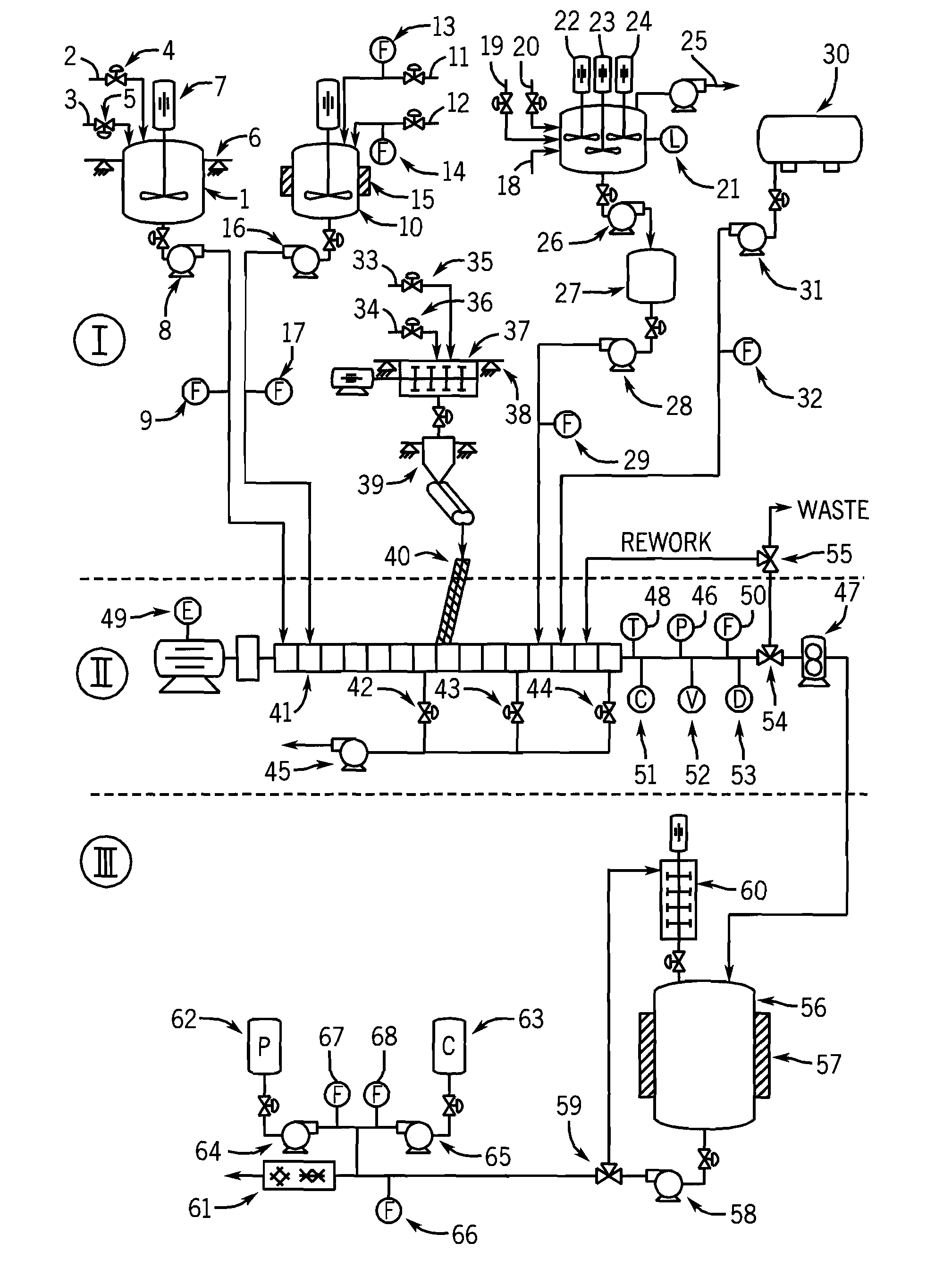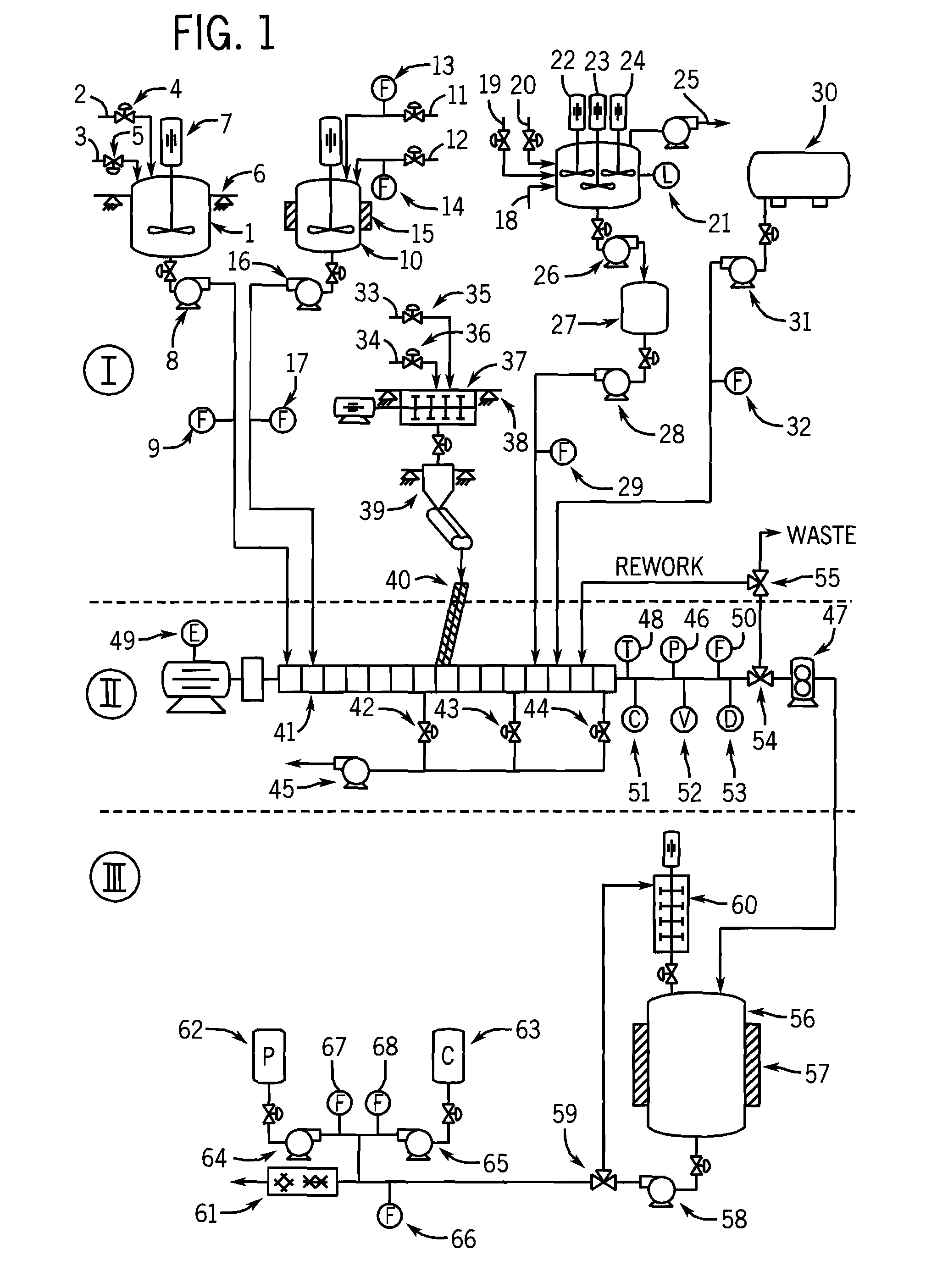Continuous Process for the Production of Moisture-Cure, Polyurethane Sealants and Adhesives
a technology of polyurethane sealants and continuous process, which is applied in the manufacture of artifical filaments, fibre chemical features, textiles and paper, etc., can solve the problems of high degree of capital investment and sophistication, undesirable safety issues may be introduced, and the batch manufacturing approach outlined above is inefficient and undesirable, so as to minimize reduce the need for cleaning equipment, and reduce the effect of surface area to volume ratio
- Summary
- Abstract
- Description
- Claims
- Application Information
AI Technical Summary
Benefits of technology
Problems solved by technology
Method used
Image
Examples
example 1
[0058]Polyurethane adhesive formulation 1 is produced using one-step prior art batch manufacturing process outlined previously. Plasticizers, polyols, fillers and other functional additives are charged into a high-intensity mixer to uniformly mix and disperse the ingredients. Vacuum is applied to the mixer to remove any residual moisture that may be introduced with the raw materials. Once this non-reactive pre-mix is below the defined moisture specification, the isocyanate, catalyst and other functional ingredients are then added to the mixer. The product is maintained at a target temperature of 160° F. for four hours to complete the reaction. Table 1 summarizes the process conditions and performance characteristics of the resultant product:
TABLE 1ParameterValueReaction temperature160°F.Viscosity152,000CpsTensile strength1111psiElongation1401%Modulus185psiShore A hardness146Lap shear strength1112psi1All samples for mechanical testing were aged one week at room temperature
example 2
[0059]Polyurethane adhesive formulation 1 is produced using a continuous process in accordance with the present invention on a twin-screw extruder by feeding the polyol preblend into the first barrel section of the mixer, followed immediately thereafter (within four screw diameters) by the isocyanate(s). These two ingredients are mixed slightly while they are transported downstream using conveying elements. Within six screw diameters a preblend including a fraction of the catalyst is introduced to help drive the reaction in the first zone of the mixer. Shortly after the addition of the catalyst preblend, an alternating series of mixing and conveying elements are used to promote intimate mixing between the polyol, isocyanate and catalyst groups and promote the urethane reaction. This mixing continues for between 10 to 20 screw diameters and ends with the introduction of an additive preblend (in this case consisting of a chemical desiccant, viscosity modifier and adhesion promoter). C...
example 3
[0060]Polyurethane adhesive formulation 2 is produced using one-step batch manufacturing process outlined previously. Plasticizers, polyols, fillers and other functional additives are charged into a high-intensity mixer to uniformly mix and disperse the ingredients. Vacuum is applied to the mixer to remove any residual moisture that may be introduced with the raw materials. Once this non-reactive pre-mix is below the defined moisture specification, the isocyanate, catalyst and other functional ingredients are then added to the mixer. The product is maintained at a target temperature of 160° F. for four hours to complete the reaction. Table 3 summarizes the process conditions and performance characteristics of the resultant product:
TABLE 3ParameterValueReaction temperature160°F.Viscosity191,000CpsTensile strength1141psiElongation1312%Modulus1120psiShore A hardness142Lap shear strength1155psi1All samples for mechanical testing were aged one week at room temperature
PUM
| Property | Measurement | Unit |
|---|---|---|
| molar ratio | aaaaa | aaaaa |
| temperatures | aaaaa | aaaaa |
| length | aaaaa | aaaaa |
Abstract
Description
Claims
Application Information
 Login to View More
Login to View More - R&D
- Intellectual Property
- Life Sciences
- Materials
- Tech Scout
- Unparalleled Data Quality
- Higher Quality Content
- 60% Fewer Hallucinations
Browse by: Latest US Patents, China's latest patents, Technical Efficacy Thesaurus, Application Domain, Technology Topic, Popular Technical Reports.
© 2025 PatSnap. All rights reserved.Legal|Privacy policy|Modern Slavery Act Transparency Statement|Sitemap|About US| Contact US: help@patsnap.com


